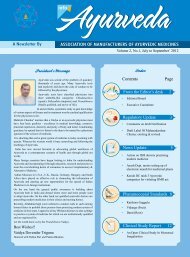ishing You Happy New Year - amam-ayurveda.org
ishing You Happy New Year - amam-ayurveda.org
ishing You Happy New Year - amam-ayurveda.org
Create successful ePaper yourself
Turn your PDF publications into a flip-book with our unique Google optimized e-Paper software.
Pharmocopial Standards For Ayurvedic Formulations<br />
and Raw Material<br />
Vasavleha (AFI, Part I, 3:26)<br />
okldLojlizLFks flrke”ViyksfUerke~A<br />
lfiZ”kks f}iya nÙok fiIiyhf}iya rFkkAA82AA<br />
ipsYysgRoek;krs ‘khrs e/kq iyk”Vde~A<br />
nÙokorkj;s}S|ks ek=;k ysg mÙke%AA83AA<br />
fugfUr jkt;{ek.ka dkla Üokla lqnk:.ke~A<br />
ikÜoZ’kwy´p âPNwya jäfiÙkToja rFkk AA84AA<br />
¼HkS’kT;jRukoyh] jkt;{ekf/kdkj( 82&84½<br />
1. Vass Svarasa (Vasa) (Lf.) 768 g<br />
2. Sita 384 g<br />
3. Sarpi (Goghrita) 96 g<br />
4. Pippali (Fr.) 96 g<br />
5. Madhu 384 g<br />
Dose: 6 to 12 g<br />
Anupana: Milk, Water<br />
Important Therapeutic Uses:<br />
Kasa (Cough), Shvasa (Dyspnoea/Asthma), Jvara (Fever), Raktapitta<br />
(Bleeding disorder), Rajayakshma (Tuberculosis), Parshava shula<br />
(Intercostal neuralgia and pleurodynia), Hritshula (Angina pectoris)<br />
Main Ingredients of Vasavleha<br />
VASA (Leaf)<br />
SYNONYMS<br />
Sanskrit : Vrisha, Atarusha, Vasaka<br />
Assamese : Titabahak, Bahak, Vachaka<br />
Bengali : Baksa, Vasaka<br />
English : Vasaka<br />
Gujrati : Aduso, Ardusi, Adulso<br />
Hindi : Aduss, Arusa<br />
Kannada : Adsale, Adusoge, Atarusha, Adsole, Adasale<br />
Kashmiri : Vasa<br />
Malayalam : Attalatakam, Atalotakam<br />
Marathi : Vasa, Adulsa<br />
Oriya : Basanga<br />
Punjabi : Bhekar, Vansa, Arusa<br />
Tamil : Vasambu, Adathodai<br />
Telugu : Addasaramu<br />
Urdu : Adusa, Basa<br />
DESCRIPTION<br />
a) Macroscopic<br />
Leaves, 10-30 cm long and 3-10 cm broad, lanceolate to ovate-lanceolate,<br />
slightly acuminate, base tapering, petiolate, petioles 2-8 cm long,<br />
exstipulite, glabrescent, 8-10 pairs of lateral vein bearing few hairs, dried<br />
leaves dull brown above, light greyish brown below, odour, characteristic,<br />
taste, bitter.<br />
b) Microscopic<br />
Transverse section of leaf shows, dorsiventral surface with 2 layers of<br />
palisade cells, in surface view, epidermal cells sinuous with anomocytic<br />
stomata on both surfaces,<br />
more numerous on the lower, clothing trichomes few, 1-3, rarely upto 5<br />
celled, thinwalled, uniseriate, upto 500 μ and glandular trichomes with<br />
nicellular stalk and 4 celled head measuring, 25-36 μ in diameter in<br />
surface view, cystoliths in mesophyll layers, elongated and cigar shaped,<br />
acicular and prismatic forms of calcium oxalate crystals present in<br />
mesophyll , palisade ratio, 5-6, 5-8.5, stomatal index, 10.8-14.2-18.1 for<br />
lower surface.<br />
IDENTITY, PURITY AND STRENGTH<br />
Foreign matter: Not more than 2 per cent,<br />
Total Ash: Not more than 21 per cent,<br />
Acid-insoluble ash: Not more than 1 per cent,<br />
Alcohol-soluble extractive: Not less than 3 per cent,<br />
Water-soluble extractive: Not less than 22 per cent,<br />
CONSTITUENTS - Alkaloids and essential oil<br />
Vasa consists of fresh, dried, mature leaves of Adhatoda vasica Nees<br />
(Fam. Acanthaceae), a sub-herbaceous bush, found throughout the year in<br />
plains and sub- Himalayan tracts in India, ascending upto 1200m, flowers<br />
during February-March and also at the end of rainy season, leaves stripped<br />
off from older stems and dried in drying sheds.<br />
PROPERTIES AND ACTION<br />
Rasa: Tikta, Kashaya<br />
Guna: Laghu<br />
Veerya: Shita<br />
Vipaka: Katu<br />
Karma: Kaphapittahara, Raktasamgrahika, Kasaghna, Hridya<br />
IMPORTANT FORMULATIONS –<br />
Vasakasava, Vasavaleha<br />
www.<strong>amam</strong>-<strong>ayurveda</strong>.<strong>org</strong> 12




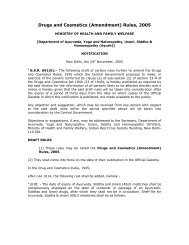
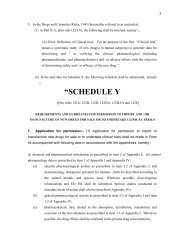
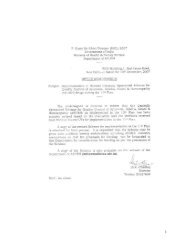




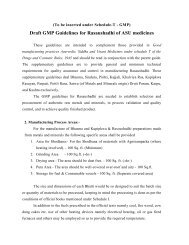

![[To be published in Gazette of India Part II Section 3, sub-section iii]](https://img.yumpu.com/28570283/1/190x245/to-be-published-in-gazette-of-india-part-ii-section-3-sub-section-iii.jpg?quality=85)

